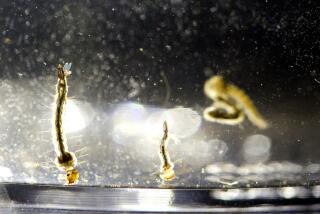MICROBES: Glow Signals Role : Glow Signals Role for Microbes in Industry
Bacteria that glow in the dark have found useful work detecting toxic chemicals in waste water.
Carlsbad-based Microbics expects to break into the black this fiscal year with its Microtox testing units--the original model 2055 and the brand new model 500.
The machines, which are slightly larger than a videocassette recorder, accept small, compact test tubes called âcuvettesâ filled with luminescent bacteria that are used to do the testing. The cuvettes are lowered into a dark chamber inside the machine, where the light emitted by the bacteria is measured.
First, the amount of light emitted by the bacteria alone in their solution is checked. Then the fluid to be tested is mixed with the bacteria. After a 5- to 15-minute wait, a reading is taken on this mix, and if the light level has dropped substantially, something toxic has probably stunned the microscopic marine creatures.
In the last 10 years, more than 400 of the 2055s have sold at a price of up to $14,000 each. The new $15,000 model 500, which goes into production later this month, is more versatile and easier to use, and has already attracted at least 20 orders.
Microbics President Don Isenberg, who prefers a casual, tieless style of management, is excited about his 5-year-old companyâs future. He expects Microbics to turn its first profit in the fiscal year to end this June. Sales will exceed $1 million, he said.
âWeâve just clipped the edge of the market,â he said. His optimism is shared by industry trade publications including Pharmacopeial Forum, which say the use of luminescent bacteria to test fluids for toxicity is fast, economical and reliable in certain applications.
Among the places where the Microtox is being used are waste-water treatment plants in Carlsbad and Point Loma. The Microtox is used to monitor both influent, or incoming waste water, and effluent, or outgoing treated waste water.
The product is also being used by large petroleum companies that treat polluted water and by municipalities and governmental agencies, including the federal Environmental Protection Agency, as well as its counterparts in Sweden and France.
Apparently, Microbics has no direct competitors. Turner Designs in Sunnyvale, however, uses Microbicsâ freeze-dried bacteria in its $5,500 âLuminometer,â which does similar tests.
âThey have a lock on the reagent technology,â said Jim McCormick of Turner, referring to the method of storing and reactivating bacteria developed by Microbics.
Fleas and fish are among the other animals used to determine whether or not water or soil samples contain toxic materials. Microbicsâ advantage is that people seem to have an easier time accepting the possible demise of a bunch of tiny bacteria than a school of writhing trout. Also, experts say, both the fish and flea tests are more costly and time-consuming than the Microtox tests.
Besides these so-called âbioassays,â or tests that use living organisms, there are various chemical tests for the presence of specific toxins. But these can cost several times the $30 to $60 the Microtox bioassays cost.
Actually, the 55-year-old Isenberg doesnât claim his products replace sophisticated methods of chemical testing. Indeed, the Microtox doesnât reveal what is in a sample, only that itâs causing the bacteriaâs healthy glow to fade. This tells a waste-water plant, for example, that something bad is coming in or going out and that more in-depth testing may be necessary.
âItâs very useful, and it does save money,â said Walter Konopka, a senior chemist at the city of San Diegoâs Point Loma waste-water treatment plant.
But Bob Bastian, an environmental engineer with the EPA in Washington, cautioned that the Microtox units often render results that differ from alternative tests.
âLine it up next to tests that use fleas or flathead minnows, run chronic and acute tests, and you will come up with different numbers,â he said, adding that itâs debatable whether the Microtox system has universal application in waste-water treatment.
Even if only a fraction of waste-water treatment plants are interested, though, the market appears large. Bastian said there are 15,500 EPA-issued permits for these facilities in the United States. And, he noted, the 1987 Clean Water Act amendments call for closer monitoring for polluted water being discharged into lakes, rivers and oceans. As a result, bioassay testing will become fairly routine, he said.
âThat bodes better for Microtox and other approaches,â Bastian said.
One waste-water treatment expert was more optimistic than Bastian about the prospects for the Microtox. âMost operators donât care about specifics,â said Brian Symons, an environmental engineer at Remediation Technology, a Ft. Collins, Colo.-based hazardous waste management consulting firm. âThey just want to know if whateverâs coming into the plant is going to disrupt their operation.â
The Microtox has yet to receive the EPAâs blessing as a standard test device. Such an approval would enhance the companyâs prospects. But, even without it, waste-water treatment plants and other operations will want the Microtox as a simple indicator of toxicity, Symons said.
Microbicsâ testing system was originally developed by Isenberg and other researchers at North American Rockwell for the Air Force in the early 1960s as a tool for detecting chemical warfare. But the military selected a different technology, and the glow bug idea lay dormant until 1968, when Isenberg moved west with a group of researchers from Rockwell to set up a microbiology research unit at Beckman Instruments in Fullerton.
At one point, Isenbergâs team came close to selling a bacteria-based toy to Mattel. A prototype, a small black box containing the organisms, was produced. The microbes were linked to a buzzer which hummed merrily when they were alive and happy. But when toxics such as cigarette smoke were blown their way, the humming faded.
Idea Was Scratched
âThe toy guys loved it,â recalled Nelson Winkless, corporate communications manager at Microbics. âThey went bananas. At the end, someone asked for the technical name, and they found out it was bacteria. Mattel had had those in their Incredible Edibles, which were banned by the FDA. So that struck this idea dead on the spot.â His assurances that the marine bacteria were harmless had no effect.
By the late â70s, Isenbergâs division at Beckman, already known as Microbics, had developed the model 2055. The key was finding a way to store the bacteria with a longer shelf life, a problem Microbics solved with a method of freeze drying. Whatâs the secret?
âDamned if Iâm going to tell you,â Isenberg said. And, he added, itâs impossible to tell how the bacteria have been put in the powdery form to which users add liquid to activate them for testing.
After SmithKline acquired Beckman in 1982 and decided to focus its resources in health care, Microbics was sold to a group including Isenberg, Dr. Anthony Bulich, who led the development of Microtox technology, and Jim Dowe, a computer software executive. SmithKline Beckman retained a minor interest in the new company. Isenberg refused to disclose the purchase price but said it was in the âhundreds of thousands of dollars.â
Today, as pre-orders for the Microtox 500 begin to roll in, Microbics is looking for new ways to put the effervescent bacteria to work.
One possibility is using them to test such medical items as catheters, pacemakers and containers for the presence of toxic materials.
As for the companyâs exact financial status, Isenberg, who, with Bulich and Dowe, own a majority of the companyâs stock, wouldnât be specific. But there are signs.
The companyâs 20 employees represent a fivefold increase since they opened in 1984, when the original three partners and a secretary ran the whole show. A new, 18,000-square-foot office-warehouse is roughly triple the size of the companyâs former quarters nearby in Carlsbad. Soon, several part-time workers will be hired to produce the first batch of Microtox 500s.
Perhaps the unemployment rate among bacteria is about to drop too.
More to Read
Inside the business of entertainment
The Wide Shot brings you news, analysis and insights on everything from streaming wars to production â and what it all means for the future.
You may occasionally receive promotional content from the Los Angeles Times.










